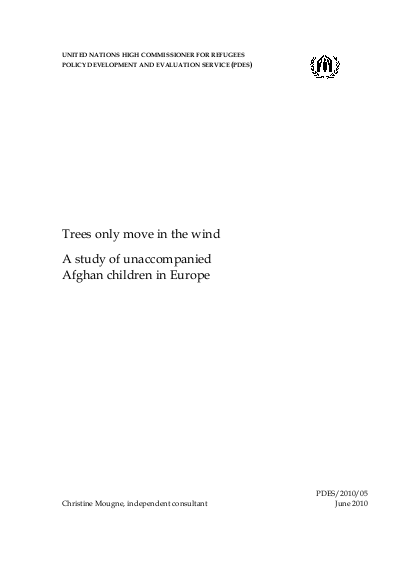
The arrival of unaccompanied and separated children from other parts of the world, some of whom submit applications for refugee status, has been an issue of mounting concern to many European countries and to UNHCR. That concern derives from a number of different factors, including: • the growing number of children involved in this movement; • the grave risks encountered by these children as they make their way to Europe; • the involvement of human smuggling networks in their movement; • the perceived misuse of asylum systems by some of those who submit claims for refugee status; • the lack of protection and assistance for children who do not submit asylum claims, though they might qualify for protection, as well as those whose protection needs are not correctly assessed; • the cost of providing the new arrivals with appropriate forms of care and support; and, • the difficulties involved in determining the age and best interest of these young people and finding a solution to their situation.
Afghans constitute one of the largest groups of unaccompanied children who are currently making their way to Europe and who are in some but not all instances submitting applications for refugee status there.1 A major problem for UNHCR in its efforts to formulate a coherent and consistent approach to this movement has been a lack of information with regard to their profile. While some relevant studies have recently been conducted on this issue, the number of cases and countries covered has been limited.2
The current study was requested by UNHCR’s Regional Bureau for Europe and commissioned by the organization’s Policy Development and Evaluation Service in an attempt to address this gap. Further information with regard to the
background, scope, purpose and methodology of the study can be found in Annexes 1 and 2.
Interviews with approximately 150 young Afghans, all of them boys, were conducted in France, Greece, Italy, the Netherlands, Norway and the UK by members of the PDES team and an internal consultant, between November 2009 and March 2010. Additional information on 38 young Afghans in Turkey and 10 in the UK was also included in the analysis. Focal points were identified in the UNHCR offices in Ankara, Kabul, Islamabad and Teheran, who also provided inputs to the study.
While a considerable number of young Afghans were interviewed in the course of this study, the findings cannot be considered as statistically significant. Interviews took place where and when the researchers were able to find children who were willing to talk. Furthermore, only those children who were willing to be interviewed were included in the study.
In each case, young Afghans were given an explanation with respect to the purpose of the study, the confidentiality of interviews and their voluntary nature. Ultimately, therefore, the study is based on a self-selected group.
It is also important to note that children may not necessarily provide accurate information when interviewed in this way. Their responses may well be influenced by the coaching of parents, relatives, other migrants or smugglers, as well as legal and other advisors in the country of asylum in responding to similar questions posed by the authorities and other stakeholders. Stress, anxiety and language difficulties might also influence the quality of the children’s responses.
An important limitation of the study has been the research team’s inability to travel to the region of origin and to examine first-hand the motivations and expectations of families who have encouraged or allowed their children to set out on such a dangerous journey. It should be noted, however, that there is considerable consistency between the findings of this study and that carried out recently by UNICEF Kabul, which included interviews with families in Afghanistan.